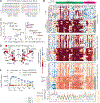High-Throughput Discovery and Characterization of Human Transcriptional Effectors
- PMID: 33326746
- PMCID: PMC8178797
- DOI: 10.1016/j.cell.2020.11.024
High-Throughput Discovery and Characterization of Human Transcriptional Effectors
Abstract
Thousands of proteins localize to the nucleus; however, it remains unclear which contain transcriptional effectors. Here, we develop HT-recruit, a pooled assay where protein libraries are recruited to a reporter, and their transcriptional effects are measured by sequencing. Using this approach, we measure gene silencing and activation for thousands of domains. We find a relationship between repressor function and evolutionary age for the KRAB domains, discover that Homeodomain repressor strength is collinear with Hox genetic organization, and identify activities for several domains of unknown function. Deep mutational scanning of the CRISPRi KRAB maps the co-repressor binding surface and identifies substitutions that improve stability/silencing. By tiling 238 proteins, we find repressors as short as ten amino acids. Finally, we report new activator domains, including a divergent KRAB. These results provide a resource of 600 human proteins containing effectors and demonstrate a scalable strategy for assigning functions to protein domains.
Keywords: CRISPRi; Hox; KRAB; chromatin regulation; deep mutational scan; domain of unknown function; high-throughput screening; mammalian synthetic biology; protein domains; transcriptional effectors.
Copyright © 2020 Elsevier Inc. All rights reserved.
Conflict of interest statement
Declaration of Interests Stanford University has filed a provisional patent related to this work.
Figures






References
-
- Ballas N, Battaglioli E, Atouf F, Andres ME, Chenoweth J, Anderson ME, Burger C, Moniwa M, Davie JR, Bowers WJ, et al. (2001). Regulation of neuronal traits by a novel transcriptional complex. Neuron 31, 353–365. - PubMed
Publication types
MeSH terms
Substances
Grants and funding
LinkOut - more resources
Full Text Sources
Other Literature Sources
Research Materials

